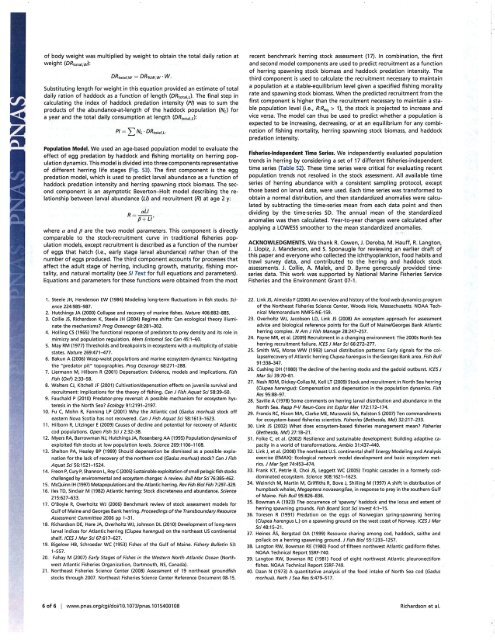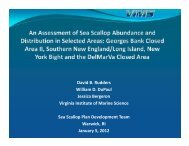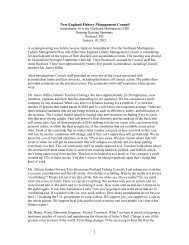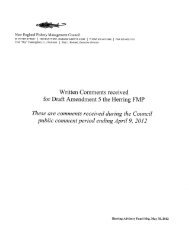Correspondence/Amendment 5 Comments - New England Fishery ...
Correspondence/Amendment 5 Comments - New England Fishery ...
Correspondence/Amendment 5 Comments - New England Fishery ...
You also want an ePaper? Increase the reach of your titles
YUMPU automatically turns print PDFs into web optimized ePapers that Google loves.
zt<br />
ã¡<br />
'. j<br />
,i<br />
of body weight was mult¡pl¡ed by we¡ght to obta¡n the total daily rat¡on at<br />
weight (DRt"t"l,w):<br />
DRtot"¡w : DRww,w'W.<br />
Subfituting length for weight ¡n th¡s equat¡on prov¡ded an est¡mate of total<br />
daily ration of haddock as a function of length (DRtot"r.J. The linal step in<br />
calculating the index of haddock predat¡on intens¡ty (PD was to sum the<br />
products of the abundance-atlength of the haddock population (lV¿) for<br />
a year and the total daily consumption at length (DR1q1"¡,¿):<br />
pt :DNL.DRþE:.L.<br />
Population Model. We used an age-based populat¡on model to evaluate the<br />
effect of egg predation by haddock and fishing mortality on herring populat¡on<br />
dynamics. This model !s divided into three components representat¡ve<br />
of different herring life stages (F¡9. 53). The first component is the egg<br />
predation model, which is used to pred¡ct larval abundance as a funct¡on of<br />
haddock predat¡on intens¡ty and herring spawning stock biomass. The second<br />
component is an asymptotic Beverton-Holt model descr¡b¡ng the relationship<br />
between larval abundance (L/) and recruitment (R) at age 2 y:<br />
- sLl<br />
t.: þ+u'<br />
where a and þ arc the two model parameters. Th¡s component is d¡rectly<br />
comparable to the stock-recruitment curve in trad¡t¡onal fisheries population<br />
models. except recru¡tment is described as a function of the number<br />
of eggs that hatch (i.e., early rtage larval abundance) rather than of the<br />
number of eggs produced. The third component accounts for processes that<br />
affect the adult stage of herríng, including growth, maturity, físhing mortal¡ty,<br />
and natural mortality (see 5/ Iext for full equat¡ons and parameters).<br />
Equat¡ons and parameters for these functions were obtained from the most<br />
1. Steele JH, Hendeßon EW (1984) Modeling long-tem lluctuations in lish stocks. Science<br />
2241985-987 -<br />
2. Hutch¡ngs JA (2000) Collapse and recovery of marine f¡shes. Nature 406:882-885.<br />
3. Collie J5, Richardson K steele JH (2004) Reg¡me sh¡fts: Can ecological theory illuminate<br />
the mechan¡sms? Prog Oceanogr 60:281-302.<br />
4. Holling CS (1 965) The funct¡onal response of predators to prey dens¡ty and ¡ts role in<br />
mim¡cry and populat¡on regulat¡on. Mem Entomol Soc Can 45:1-60.<br />
5. May RM (1977) Thresholds and breakpoints in ecosystems w¡th a multipl¡c¡ty of stable<br />
slates - N at u re 269 t47 1 47 7 -<br />
6. Bakun A (2006) Wasp-waist populat¡ons and marine ecosystem dynamics: Navigating<br />
the "predator p¡t" topographies. Prog Oceanogr 68:271-288.<br />
7. Liermann M, H¡lborn R (2001) Depensation: Ev¡dence, models and impl¡câtions. Fr'sh<br />
Fish (Oxf) 213T58.<br />
8. Wâlteß O. K¡tchell JF (2001) Cult¡vation/depensat¡on effects on juvenile survival and<br />
recru¡tment: lmplicâtions for the theory of fishing. Can J Fish Aquat Sci 58139-50-<br />
9. Fauchald P (2010) Predâtor-prey reversal: A possible mechanism for ecosylem hysteres¡s<br />
¡n the North sea? Ecology 91:2191-2197.<br />
10. Fu C, Mohn R, Fann¡ng LP (2001) Why the Atlântic cod (Gadus morhua) stæk off<br />
eastern Nova Scot¡a has not recovered. Can J Fish Aquat Sc¡ 58:1613-1623.<br />
1 1. H¡lborn R, L¡tzinger E (2009) Causes of decline and potent¡al for recovery of Atlantic<br />
cod populations. Open Fish Sci J 2:32-38.<br />
12. MyersRA"BârrowmanNJ,HutchingsrA,RosenbergAA(,l995)Populationdynamicsof<br />
explo¡ted f¡sh stock at low population levels. Scænce 269:1 106.1 108.<br />
13. Shelton PA, Healey BP (1999) Should depensat¡on be d¡smi$ed as a possible explanation<br />
for the lack of recovery of the northern cod (Gadus morhua, saock? Can J F¡sh<br />
Aq uat Sci 56:1521 -1524 -<br />
14. FreonP,CuryP,Shannonl-RoyC(2005)Sustainableexplo¡tat¡onofsmallpelagicfishsttrks<br />
challenged by env¡ronrental and trGt6tem châng6: A revieu Bull Mar ki 761385-42.<br />
15. M(Qu¡nnlH(1997)MetapopulationsandtheAtlanticherring.RevF¡shB¡olF¡sh7:297-329.<br />
16. lles TD, 5¡nclair M (1982) Atlant¡c herr¡ng:stock dirreteness and abundance. Science<br />
215t627-433.<br />
17. O'Boyle R, Overholtz WJ (2006) Benchmark review of stock assessment models for<br />
Gulf of Ma¡ne ând Georges Eank herr¡ng - Prcceedings ofthe Transboundaty Resource<br />
Assessment Committee 2006 pp 1-31.<br />
'18. RichardsonDE,HareJA"OverholtzWJ,JohnsonDL(2010)Developmentoflong-term<br />
larual ¡ndices for Atlant¡c herring (Clupea harengus) on the northeast US cont¡nentâl<br />
shelf- ICES J Mar 67:617-527.<br />
19. B¡gelow HB, Schroeder 'ci WC (1953) F¡shes of the Gulf of Maine. Fishety Bulletin 53:<br />
1-557.<br />
20. Fahay M (2007) Early Stages of Fishes ¡n the Western ¡vorth Atlantrc Ocean (Northwest<br />
Atlant¡c Fisheries Organ¡zat¡on, Dartmouth, NS, Canada).<br />
21. Northean F¡sher¡es Sc¡ence Center (2008) Assessment of 19 northeast groundfish<br />
stoclc through 2007. Northeast Fisheries sc¡ence Cent€r Reference Document 08-1 5.<br />
6 of 6 | www.pnas.orgy'cAi/doi/l0.1073/pnas.1015400108<br />
recent benchmark herring stock assessment (17). ln combination, the first<br />
and second model components are used to predict recru¡tment as a function<br />
of herring spawning stock b¡omass and haddock predation intensity. The<br />
th¡rd component is used to calculate the recru¡tment necessary to maintain<br />
a population at â stable-equil¡brium level given a specified fishing morality<br />
rate and spawning stock biomass. When the predicted recruitment from the<br />
first component is higher than the recru¡tment necessary to maintain a stable<br />
population level (i.e., R:R"o > 1), the stock ¡s projected to ¡ncrease and<br />
vice versa. The model can thus be used to predict whether a population is<br />
expected to be increasing, decreasing, or at an equilibrium for any combÈ<br />
nation of fishing mortality, herring spawning stock biomass, and haddock<br />
predation ¡ntens¡ty.<br />
Fisheries-lndependent Ρme Series. We independently evaluated population<br />
trends in herring by considering a set of 17 different fisheries-independent<br />
t¡me series (Table 52). These time series were critical for evaluat¡ng recent<br />
population trends not resolved in the stock assessment. All available time<br />
series of herring abundance w¡th a cons¡stent sampl¡ng protocol, except<br />
those bâsed on larval data, were used. Each time series was transformed to<br />
obta¡n a normal distribution, and then standardized anomalies were calculated<br />
by subtract¡ng the t¡me-ser¡es mean from each data point and then<br />
dividing by the t¡me-ser¡es 5D. The annual mean of the standardized<br />
anomalies was then calculated. Year-to-year changes were calculated after<br />
applying a LOWEss smoother to the mean standardized anomalies.<br />
ACKNOWTEDGMEMTS. We thank R. Cowen, J. Deroba, M. Hauff. R. Langton,<br />
J. Llopiz, J. Manderson, and 5. Sponaugle for reviewing an earlier draft of<br />
this paper and everyone who collected the ¡chthyoplankton, food habits and<br />
trawl survey data, and contributed to the herr¡ng and haddock stock<br />
assessments. J. Collie, A. Malek, and D. Byrne generously prov¡ded timeseries<br />
data. This work was supported by National Marine Fisheries Service<br />
Fisheries and the Environment Grant 07-1.<br />
22. Link J5, Almeidâ F (2000) An overuiew ând history of the food web dynamics program<br />
of the Northeast Fisheries Science Center. Wæds Hole. Massachusetts. NOAA Techn¡cal<br />
Memorandum NMFS-NE-1 59.<br />
23. Overholtz WJ, Jacobson LD, Link JS (2008) An ecosylem approach for asse$ment<br />
advice and biological reference po¡nts for the Gulf of Maine/Georges Bank Atlant¡c<br />
herring complex. ,V Am J Fish Manage 28247-257.<br />
24. Payne MR, et al. (2009) Recruitment in a chang¡ng environment The 2000s North Sea<br />
herring rtrruitment lailurè. ICES J Mar Sci 661272-277.<br />
25. Smith WG, Morse \ /W (1993) Låruâl distr¡but¡on patterns: Early signals for the collapse/recovery<br />
of Atlantic herring C/upea harengus in the Gærges Bank area. Fish Bul/<br />
91:338-347.<br />
26. Cush¡ng DH (1980) The decl¡ne ofthe herring stocks and the gadoid outburst. ,CES./<br />
Mar sri39t7H1-<br />
27. Nash RDM, Dickey-Collas M, Kell LT (2009) sttrk ånd recru¡tment in North Sea herr¡ng<br />
(Clupea harenguslt Compensation and depenstion in the populãtion dynâmi6. Fril,<br />
Res 95:8&-97.<br />
28. Saville A (1978) Some comments on herring larval distr¡bution and âbundancê in the<br />
North sea. Rapp P-V Reun-Cons lnt Explor Mer 1721172-174-<br />
29. Franc¡s RC, Hixon MA, clarke ME, Murâski 54, Ralston S (2007) Ten commandments<br />
for ecosystem-bâsed f¡sheries scientists- Fisheries (Bethesda, Md) 32:217-233-<br />
30. Link JS (2002) What does ecosystem-based fisheries management mean? Fisl¡eræs<br />
(Bethesda, Md) 27 t18-21.<br />
31. Folke C, et al. (2002) Resil¡ence ând sustâinable development:8u¡ld¡ng adapt¡ve câpacity<br />
in a world of transformations. Ambio 31i437440.<br />
32. LinkJ,etal.(2008)ThenortheastU.S.cont¡nentalshelfEnergyModelingandAnalysis<br />
exercise (EMAX): Ecological network mode¡ development and basic ecosystem metti6.<br />
J Mar 5yst74t453474.<br />
33. Frank KT, Petrie B, Choi J5, Leggett WC (2005) Troph¡c câscades in a formerly coddominated<br />
ecosystem. Sc€nce 308:1621-1623.<br />
34. Weinrich M, Martin M, Gr¡ffiths R, Bove J, Shilling M (1997) A sh¡ft ¡n distribution of<br />
humpback whales, Megaptera novaeangliâe, in responseto prey in the southern Gulf<br />
of Maine. Fr'så Bulr 95:826-€36.<br />
35. Bowman A (1923) The occurrence of'spawny'haddGk and the locus ând extent of<br />
herring spawn¡ng gr ouîds. F ¡ sh Boa rd Scot Sci rnvest 4: I-1 5.<br />
36. Toresen R (1991) Predation on the eggs of Nomegian spring-spawning herring<br />
(Clupea harengusL) on a spawning ground on the west coast of NoMay. ,C85., Mår<br />
Sci 48115-2'l-<br />
37. Høines Å5, Berglad OA (1999) Resource sharing among cod, haddGk, sa¡the and<br />
pollack on a herr¡ng spawn¡ng ground. J Fish Eiol 55i1233-1257.<br />
38. Langton RW Bowman RE (1980) Fæd of tifteen northwest At¡ant¡c gad¡form fishes.<br />
NOAA Techn¡cal Report SSRF-740.<br />
39. Langton RW, Bowmân RE (,l98,l) Food of e¡ght northwest Atlânt¡c pleuronectifom<br />
f¡shes. NOAA Techn¡cal Report SSRF-749.<br />
40. Daan N (1973) A quant¡tative analys¡s of the food ¡ntake of North Sea cod (Gadus<br />
morhua)- Neth J Sea Res 6:479-517.<br />
R¡chardson et al.







